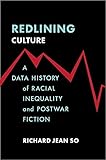Redlining Culture : A Data History of Racial Inequality and Postwar Fiction / Richard Jean So.
Material type: TextPublisher: New York, NY : Columbia University Press, [2020]Copyright date: ©2021Description: 1 online resource : 17 b&w illustrationsContent type:
TextPublisher: New York, NY : Columbia University Press, [2020]Copyright date: ©2021Description: 1 online resource : 17 b&w illustrationsContent type: - 9780231552318
- American fiction -- African American authors -- History and critcism
- American fiction -- 20th century -- History and criticism
- Authors and publishers -- United States -- History -- 20th century
- Discrimination in employment -- United States
- Literature and society -- United States -- History -- 20th century
- Literature publishing -- Political aspects -- United States -- History -- 20th century
- Literature -- Data processing
- Race discrimination -- United States -- History -- 20th century
- LANGUAGE ARTS & DISCIPLINES / Publishing
- 813/.609896073 23
- PS153.N5 S63 2021
- online - DeGruyter
| Item type | Current library | Call number | URL | Status | Notes | Barcode | |
|---|---|---|---|---|---|---|---|
 eBook
eBook
|
Biblioteca "Angelicum" Pont. Univ. S.Tommaso d'Aquino Nuvola online | online - DeGruyter (Browse shelf(Opens below)) | Online access | Not for loan (Accesso limitato) | Accesso per gli utenti autorizzati / Access for authorized users | (dgr)9780231552318 |
Frontmatter -- CONTENTS -- ACKNOWLEDGMENTS -- INTRODUCTION -- 1. PRODUCTION: ON WHITE PUBLISHING -- 2. RECEPTION: MULTICULTURALISM OF THE 1 PERCENT -- 3. RECOGNITION: LITERARY DISTINCTION AND BLACKNESS -- 4. CONSECRATION: THE CANON AND RACIAL INEQUALITY -- CONCLUSION -- NOTES -- INDEX
restricted access online access with authorization star
http://purl.org/coar/access_right/c_16ec
The canon of postwar American fiction has changed over the past few decades to include far more writers of color. It would appear that we are making progress—recovering marginalized voices and including those who were for far too long ignored. However, is this celebratory narrative borne out in the data?Richard Jean So draws on big data, literary history, and close readings to offer an unprecedented analysis of racial inequality in American publishing that reveals the persistence of an extreme bias toward white authors. In fact, a defining feature of the publishing industry is its vast whiteness, which has denied nonwhite authors, especially black writers, the coveted resources of publishing, reviews, prizes, and sales, with profound effects on the language, form, and content of the postwar novel. Rather than seeing the postwar period as the era of multiculturalism, So argues that we should understand it as the invention of a new form of racial inequality—one that continues to shape the arts and literature today.Interweaving data analysis of large-scale patterns with a consideration of Toni Morrison’s career as an editor at Random House and readings of individual works by Octavia Butler, Henry Dumas, Amy Tan, and others, So develops a form of criticism that brings together qualitative and quantitative approaches to the study of literature. A vital and provocative work for American literary studies, critical race studies, and the digital humanities, Redlining Culture shows the importance of data and computational methods for understanding and challenging racial inequality.
Mode of access: Internet via World Wide Web.
In English.
Description based on online resource; title from PDF title page (publisher's Web site, viewed 01. Dez 2022)


